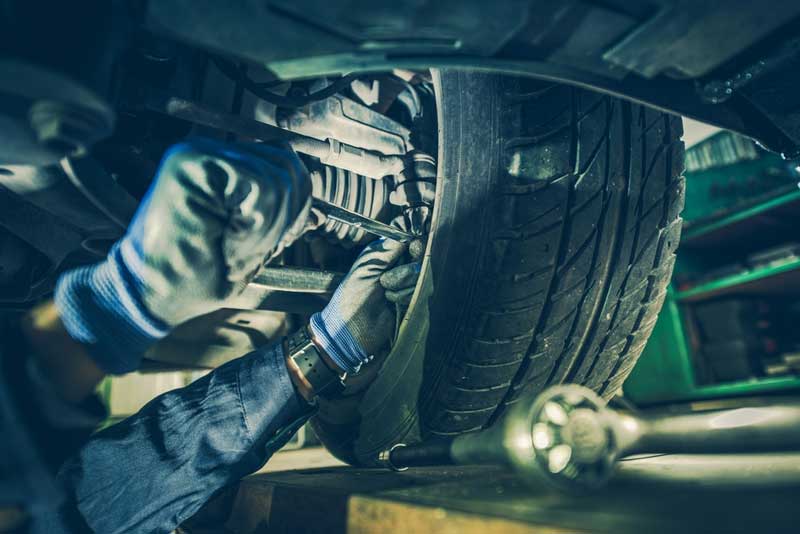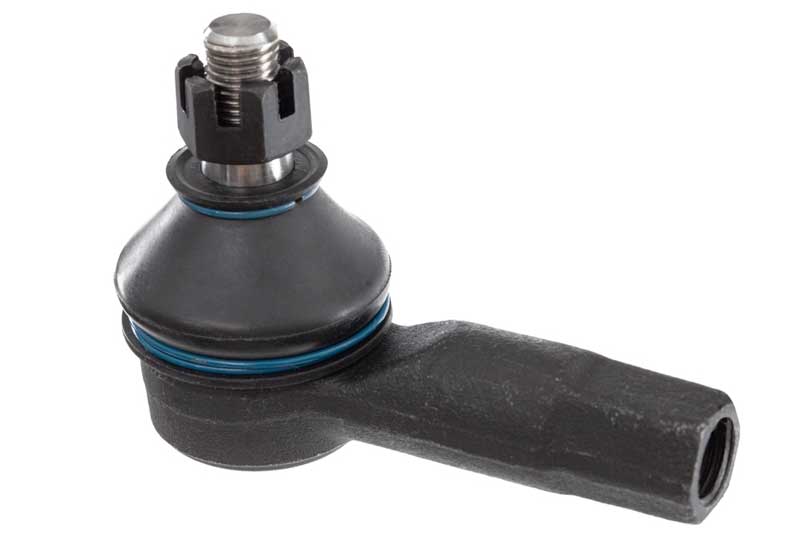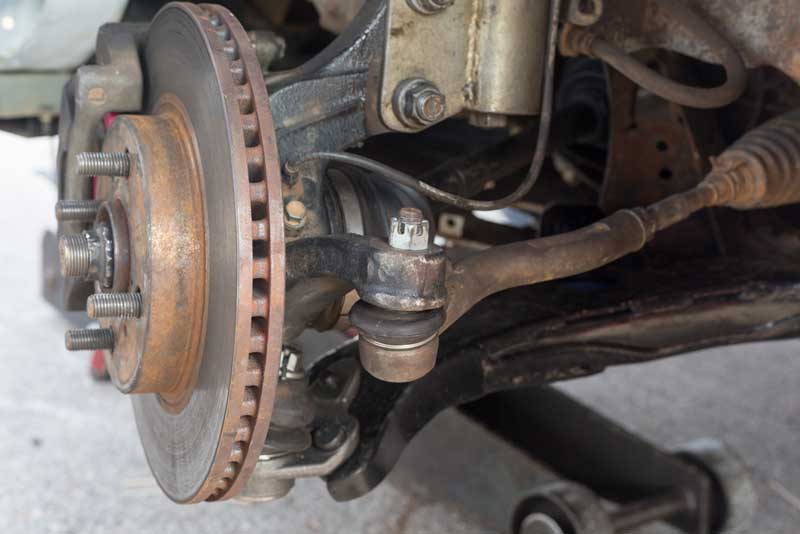Do you want to know the various bad Tie Rod symptoms so that you can easily tell if your Tie Rod is faulty? If your answer is “yes,” you are in the right place.
A faulty Tie Rod End (TRE) can cause a disturbing vibration while accelerating your car. Other bad tie rod symptoms include a misaligned front end, degrading steering ability, and disturbing noise when making fast turns.
This guide will educate you on the normal signs of Tie Rod failure, the exact affected position, and how much it would cost to have it replaced.
Enjoy the read!
What Are the Symptoms of Bad Tie Rod?
- Excessive Tire Wear
- Loose Steering Wheels
- Poor Front End Alignment
- Excessive Vehicle Vibrations
- Abnormal Noises
- Steering Wheel Vibrations
What Are Tie Rods?
These devices help connect your car’s steering rack, to the stressing knuckle. They are vital parts of the vehicle’s steering wheel, and this is due to the connections of the tie rod(TR), which comprises the outer and inner ends.
Even though it is a very important component of the vehicle, many drivers are unfamiliar with the TRE. This component is an important link of the knuckle to the steering gear and aids in safe driving operations.
When one TRE fails, it may be dangerous to drive because the car will get damaged. Therefore, it is very important to be on the lookout for signs of TRE failure, so you can take corrective measures as soon as possible.
The rod in the outer end is connected to an adjusting sleeve. This helps it adjust the TR length, and this also aids in setting the car’s alignment straight. This particular mechanism is called the rack and pinion system.
A lengthy tube inside this system called the rack connects both wheels. This rack is a cylindrically shaped rod. The rack top can accommodate a gear track, due to its grooves. This gear is known as the pinion gear and is directly connected to the SW (steering wheel). Whenever the SW is turned, the pinion gear moves and then moves the rack.
Also Read: Wheel Alignment Cost
How Do Tie Rods Function?
Assuming you are steering to the left side, both tires must move in the same direction for the car to turn left, but their motions will differ. While the right tire turns towards the left, the left tire turns outside. This is where the functions of the TR are prominent because the rack and pinion system puts pressure through the TR on the left wheel, which helps it move outwards.
Then, the TR located on the right pulls the right, when inwards. As can be deduced from the name, the major function of the TR is the connection of two parts. Once the TR binds two parts, the said parts start moving in sync.

Regular Bad Tie Rod Symptoms (Explained)
Bad tie rod symptoms include excessive tire wear, loose steering wheels, poor front-end alignment, excessive vehicle vibrations, abnormal noises, and steering wheel vibrations. Lets get to know more about these symptoms.
1. Extreme Tire Wear
Driving a car with a faulty TR can lead to uneven and excessive tire wear. A visual examination is enough to alert you of uneven tire wearing. The vehicle’s weight is evenly spread across all four tires when the suspension system is functional, and this helps the tires last long because the work is shared equally among all the tires.
But the failure of the suspension system leads to wear. This, in turn, brings about misalignment and uneven wearing of the tires. Once this is noticed, it is best to start saving up for the replacements. It is always best to fix the faulty TR as soon as possible.
2. Loose Steering Wheels
The TR helps ensure that the car’s suspension is intact. But once this starts to wear, it becomes loose. Even slight acceleration will cause the car to bounce, and cause a vibration of the SW. At 20mph, a bad TR starts vibrating, and the vibration increases as the vehicle’s acceleration increases. Even though this symptom is peculiar to a faulty inner TR, it may also happen when the tire or wheel is off-balance. Either way, you should have the vehicle examined by an expert.
3. Bad Front End Alignment
A poor front-end alignment is one of the bad Tie Rod symptoms. The TR maintains the solidity of the car’s front section. Also, note that the car’s alignment works hand in hand with other vital factors, including stabilizer bars, struts, tires, and wheels. Hence, the vehicle’s front section will become misaligned, once the TR starts wearing out. Due to this wearing, it will loosen, and it will be most noticeable when you are driving straight. The car will start pulling to a particular side.
4. Extreme Vehicle Vibrations
Asides from the fact that you can feel the SW vibrate, you may also feel a vibration in the whole vehicle. The connection of the TR to the suspension is the reason behind this. Some parts of the suspension will get loose once the TR is loose, resulting in the vibration of the whole vehicle. Also, the uneven wearing of the tires can be caused by bad TR.
Once you start feeling vibrations in your car, it implies the TRs are completely failing. As soon as you lose the TRs, you will also lose the steering. Therefore, you should check your TRs, once you feel the excessive vibrations resulting from bad TRs.
5. Unusual Noises
You will notice unpleasant sounds when your TR is not up to par. But bad TR causes squeaking or clunking sounds, which emanate from the grinding of two metals. The location these sounds emanate is difficult to locate, and that is where the problem lies because vehicles are mostly metal.
The same sounds can come from any other loose metal parts. But when you mostly notice these sounds when trying to turn to a corner, there is a probability that the issue is from the TR. Lack of grease can also bring about this issue. Friction occurs between metal parts when there is a lack of grease. This friction leads to squeaky sounds.
In another instance, you might be dealing with a faulty bushing, if what you notice is a clanking noise, which sounds like the bashing of two metals. Loosened components can make similar sounds.
6. Vibrations in Steering Wheel
Disturbance and shaking, are all signs of bad Tie Rod. This occurs when the TRs are loose. There will be a weak connection on both ends of a TR when it is loose, which warrants it to move around freely. Just as the movement of the SW is sent to the TR, so will the movements of the TR be sent to the SW.
A shaky TR will result in vibration and shaking of the SW. This issue merely gets worse, as time goes on. This issue will be much more noticeable when you make sharp turns or drive at a very high speed.
Why Do Tie Rods Malfunction?
The following are parts that connect the TR to the SW.
Failure of Ball Joints
This bearing is located at each end of the TR. The major ball joints take the major brunt, released by the TR. Their function also covers the reduction of vibration, while the vehicle is in motion. Stress leads to the failure of the ball joints. The ball joints do not absorb much pressure when you move through paved paths. But the ball joints are subjected to much pressure if you always drive on rugged paths. This is a major cause of their failure.
Damaged Rubber Bushing
Just as other components in the vehicle, TRs have protective coverings and many bushings. Bushing protects the TR from exposure to moisture, dirt, and dust as these can cause damage to the TRS. The bushing also absorbs the brunt. They come in plastic or rubber materials. Therefore, it takes and spreads the brunt that may affect the TRS.
Low or Bad Lubricant
Lubrication is important for the functionality of the Tie Rod, even though it is not part of the TR. Grease lubricates the rods. They maintain the smoothness of the TRs’ motions, by reducing friction between different components. Lubrication also helps avoid wear or damage, that may affect the TRS.
These mentioned above are the main parts that make up your TR and help it function properly. Failure of the TR may be connected to any of these parts.
Cost of Tie Rods Replacement
Minus the wheel alignment cost, replacing the TRE would cost around $70-$250. The TRE would cost about $20-$50, whereas labor would cost around $80-$100.
Once you are done with replacing a TRE, you will have to align the wheels, and the price for this alignment would be between $80-$100. For this reason, it might be best to have both TREs replaced simultaneously.
This will help you avoid aligning your wheels, after each replacement. If your vehicle is 4WD, you are advised to have all four wheels aligned.
Steps to Replacing Your Tie Rods
Step 1: Locate a flat surface, and park the vehicle. Then go ahead and loosen the lug nuts. Use your breaker bar and correct size socket, to loosen the lug nuts on the front wheels. Once you have loosened them, do not remove them.
Step 2: Lift the vehicle’s front tires using a floor jack, and make sure it is secured. If you want to lift the car, lift it from the pinch welds in cars and by the frame on trucks. You will find a reinforced part under the vehicle, or rubber pads to lift the car with. In a case where you are skeptical about how to lift the car, to be sure of the specific points to lift it from, you need to refer to your owner’s guide.
Step 3: To gain access to the steering parts, you need to unscrew the lug nuts and remove the tire.
Step 4: Turn the SW in the proper direction. The TRE should be jotting out of the vehicle.
Step 5: Get ready to remove the TRE. To loosen the nuts for the TRE, you need to use the appropriate size combination wrench. Make sure the nut is so loose to the extent, that the threads located at the end of the outer TR are exposed. Using a part, mark the threads. The particular mark will be vital during the installation of the new TRE.
Step 6: Detach the cotter pin from the TRE. Locate the 3/8 ratchet and correct size socket. Loose and detach the castle nut that holds the TRE to the steering knuckle.
Step 7: Detach the old TRE. Using the TR puller, break the TRE out of its cavity in the steering knuckle. To detach the TRE from the inner TR, you need to turn it anticlockwise and make sure you are counting the rotations, as you remove the TR. With the mark you made initially, this will be used in installing the new TRE.
Step 8: Try installing the new TRE. Using the same number of rotations you used to unscrew the old TRE, screw in the new TRE. Make sure it lines up near the mark. Next, put the other side of the TR into the cavity of the steering knuckle. Make sure the nut that holds the TRE to the knuckle, is tight. Then install it. Put the cutter pin via the TRE and fastening section. Secure the outer TRE to the inner one, by tightening the lug nut using the combination wrench.
Step 9: Do this as much as you need to. Re-do from steps 1-8, if you are to replace both TRs.
Step 10: Place the tires back, tighten the lug nuts, and lower the car. When you reinstall the tires using the floor jack, detach the safety jack stands and bring the car down. Make sure the lug nuts are tight by 1/2 -3/4.

How Long Do Tie Rods Last?
Your TRE need not go bad for any reason. TRE last more than the car’s engine most time, so they tend to last for years. Hence, you may never have to change your tires. But in some situations, TR can fail. This is usually a result of wearing, aging, or an accident. Once you notice signs of faulty TR, you should have it examined and changed if necessary.
Also Read: Brake Pad Replacement Cost
Frequently Asked Questions – Bad Tie Rod Symptoms
How can one tell if the tie rod is bad?
Can you drive with bad tie rods?
What is the result of bad tie rods?
How costly is it to replace a tie rod?
What are the dangers of driving with bad tie rods?
Final Thoughts - Bad Tie Rod Symptoms
Unless you have to turn the car’s wheels, the suspension system helps the vehicle to move straight. It also keeps the vehicle in proper alignment and good shape. But they wear out as you use the vehicle.
The wearing process is more when you drive on bumpy paths. It is a good thing that there are signs you will notice, once your TRs are beginning to malfunction. You should be able to know when your tires need replacement, from the signs you notice.
These signs are usually peculiar with faulty TRs, so it is fairly easy to note them. Noticing these signs implies that you have a failed or failing TR. You are advised to never overlook a fault TR.

